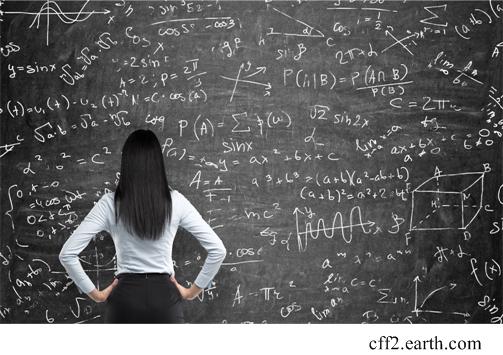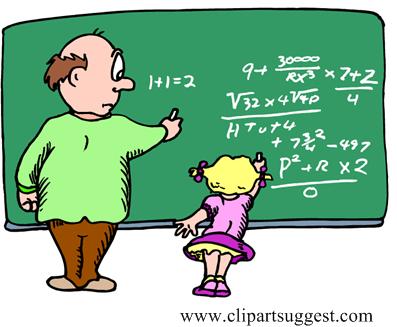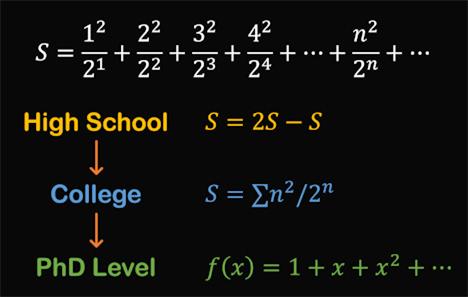 This is another challenging sum from the 2024 Math Calendar.
This is another challenging sum from the 2024 Math Calendar.
“Find x where x = et and
 ”
”
As before, recall that all the answers are integer days of the month.
See Yet Another Sum for a solution.

 This is another challenging sum from the 2024 Math Calendar.
This is another challenging sum from the 2024 Math Calendar.
“Find x where x = et and
 ”
”
As before, recall that all the answers are integer days of the month.
See Yet Another Sum for a solution.
 Here is a fairly computationally challenging 1994 AIME problem .
Here is a fairly computationally challenging 1994 AIME problem .
“Find the positive integer n for which
⌊log2 1⌋ + ⌊log2 2⌋ + ⌊log2 3⌋ + … + ⌊log2 n⌋ = 1994.
where for real x, ⌊x⌋ is the greatest integer ≤ x.”
There is some fussy consideration of indices.
See the Special Log Sum for a solution.
 Well, I discovered that the 2024 Math Calendar has some interesting problems, so I guess things will limp along for a while. This is a challenging but imaginative problem from the calendar.
Well, I discovered that the 2024 Math Calendar has some interesting problems, so I guess things will limp along for a while. This is a challenging but imaginative problem from the calendar.
_______________
As before, recall that all the answers are integer days of the month.
See the Amazing Root Problem for a solution.
 This is yet another series offered by Presh Talwalkar.
This is yet another series offered by Presh Talwalkar.
“What is the value of the following sum?
____
Talwalkar gives hints for three possible approaches to the solution.
See Another Challenging Sum for solutions.
 Here is another typical sum puzzle from Presh Talwalkar.
Here is another typical sum puzzle from Presh Talwalkar.
“Solve the following sums:
_____1/(1×3) + 1/(3×5) + 1/(5×7) + 1/(7×9) + 1/(9×11) =
_____1/(4×7) + 1/(7×10) + 1/(10×13) + 1/(13×16) =
_____1/(2×7) + 1/(7×12) + 1/(12×17) + … =”
The only reason I am including this puzzle is that Talwalkar gets very excited about deriving a formula that can solve sums of this type. This gives me an opportunity to discuss the “formula vs. procedure” way of doing math.
See the Incredible Trick Puzzle for solutions.
 This is another stimulating little problem from the 2022 Math Calendar.
This is another stimulating little problem from the 2022 Math Calendar.
“a1 = 1, a2 = 2, …, an+1 = an + 6an-1
x = lim an+1/an as n → ∞
Solve for x.”
As before, recall that all the answers are integer days of the month.
See Stimulating Sequence for a solution.
 This is another infinite series from Presh Talwalkar, but with a twist.
This is another infinite series from Presh Talwalkar, but with a twist.
“This problem is adapted from one given in an annual national math competition exam in France. Evaluate the infinite series:
1/2! + 2/3! + 3/4! + …”
The twist is that Talwalkar provides three solutions, illustrating three different techniques that I in fact have used before in series and sequence problems. But this time I actually found a simpler solution that avoids all these. You also need to remember what a factorial is: n! =n(n – 1)(n – 2)…3·2·1.
See a Nice Factorial Sum for solutions.
 This is a belated Christmas puzzle from December 2019 MathsMonday.
This is a belated Christmas puzzle from December 2019 MathsMonday.
“A Christmas tree is made by stacking successively smaller cones. The largest cone has a base of radius 1 unit and a height of 2 units. Each smaller cone has a radius 3/4 of the previous cone and a height 3/4 of the previous cone. Its base overlaps the previous cone, sitting at a height 3/4 of the way up the previous cone.
What are the dimensions of the smallest cone, by volume, that will contain the whole tree for any number of cones?”
Recall that the volume of a cone is π r2 h/3.
See Another Christmas Tree Puzzle for a solution.
 Here is another sum problem, this time from the 2021 Math Calendar.
Here is another sum problem, this time from the 2021 Math Calendar.
________________![]()
As before, recall that all the answers are integer days of the month. And the solution employs a technique familiar to these pages.
See the Winter Sum for a solution.
 Here is another problem from the 2020 Math Calendar.
Here is another problem from the 2020 Math Calendar.

As a hint, recall that all the answers are integer days of the month. And the solution employs a technique familiar to these pages.
See Autumn Sum for a solution.